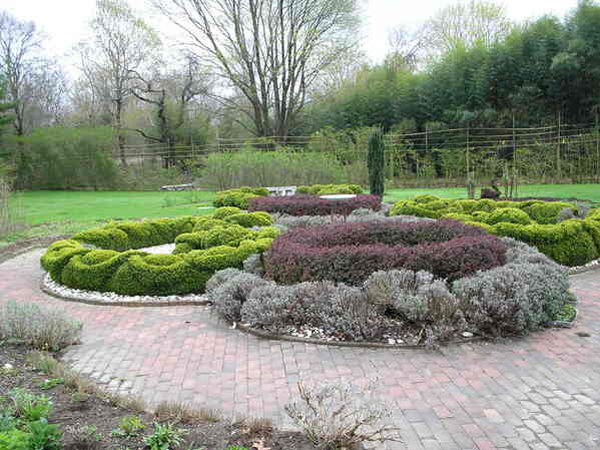
The ground beneath one’s feet, and particularly beneath one’s lawn, was the subject of an informative and timely talk given by James Sottilo, founder of East Hampton-based Ecological Landscape Management, on Saturday, April 17, at the Peconic Land Trust’s Bridge Gardens in Bridgehampton.
During his talk, Mr. Sottilo addressed a mixed audience of homeowners and landscaping professionals to explain the science behind his work, focusing on the paramount role of soil biology in healthy lawns and landscapes. Mr. Sottilo explained that soil is a living community, teeming with earthworms and other creatures and microscopic bacteria, fungi (“Fungi are absolutely my favorite organism in the world,” he declared), protozoa and other microorganisms. When the microbial life in soil is healthy, he explained, lawns and gardens thrive without fertilizers, pesticides or herbicides.
Mr. Sottilo has been involved in landscape architecture for 25 years, though he just started Environmental Landscape Management in January 2010. After studying horticulture and arboriculture, a serious health crisis in the mid-1990s inspired him to reexamine his beliefs and change the direction of his career. He then became interested in soil microbiology and learned how plants naturally create their own systems to stay healthy.
Mr. Sottilo’s company has done a lot of high-profile public projects, in addition to extensive work on private properties from Montauk to Manhattan and around the tri-state area. His favorite project, he said, is the 40-acre Brooklyn Bridge Park in New York, designed by Michael Van Valkenburgh Associates. Ecological Landscape Management was involved there from the onset, writing the soil and maintenance specifications for the park. His firm also designed and maintains the gardens on the High Line in Manhattan. On other jobs, like the one at Princeton’s Whitman College, his company was called in to save dying trees.
In all cases, Environmental Landscape Management works on the soil, not the plants.
According to Mr. Sottilo, carbon sequestration, locking up carbon to keep it out of the atmosphere, is a big topic whenever global warming is discussed. Grasslands, he said, are carbon storehouses. More than 335 billion tons of carbon are held in grasslands, 97 percent of it in the soil underneath the grass. Of that total, 15 percent (50 billion tons) is contained in the organisms living in the soil.
It stands to reason that the more microorganisms your soil contains, the more carbon it will store, Mr. Sottilo explained. “Look at your personal landscape as a carbon sink,” he urged.
A conventionally managed lawn, said Mr. Sottilo, requires just over 28 gallons of diesel fuel to fertilize one acre of lawn every year (conventional fertilizers are petroleum based). An environmentally-sustainable amount would be just 8 gallons of fuel. This figure does not include the pesticides and herbicides that also go on the average lawn.
In January, Suffolk County outlawed all lawn fertilization between November 1 and April 1, and launched a campaign to educate residents about the role fertilizer runoff poses to our water quality.
And, according to Mr. Sottilo, 7 billion gallons of water a day go onto the landscapes of America.
So how does one make their lawn sustainable? First, said Mr. Sottilo, everyone should quit dumping chemical products on their lawns.
Thatch is a big problem in many lawns. When the lawn has a thick layer of thatch, it takes extra water to penetrate to the roots and keep the grass alive. And aerating (the usual treatment) won’t get rid of it. But, where the soil is healthy and full of biological activity, thatch is not a problem. According to Mr. Sottilo, the best way to ramp up soil microorganisms is to get organic matter—most notably compost and compost tea—into the soil.
For homeowners wanting to convert to an organic lawn management program, Mr. Sottilo suggested a plan of attack: Begin by aerating the lawn in fall, and top-dress it with a ¼- to ½-inch-layer of compost. Make sure the compost used is fully decomposed, he advised, as it can’t begin working in your soil until the decomposition process is complete.
“If it feels warm when you stick your hand into the middle of it,” he said, “it’s not finished yet.”
Two weeks after spreading the compost, apply an organic fertilizer containing feather meal (read package labels to find one). Feather meal, a slow-release form of the nitrogen that grass needs to thrive, is the critical ingredient, Mr. Sottilo said.
Next spring, in mid-April, fertilize again with the feather meal-containing product, then water with compost tea at that time and again in May and July. Compost tea is a solution made by soaking compost in water.
One important caveat: compost tea must be fresh to be effective. After 12 hours, the beneficial microorganisms in compost tea begin to die off and the tea begins to lose its efficacy. Fresh compost tea is hard to find for sale, but it is possible to make it at home.